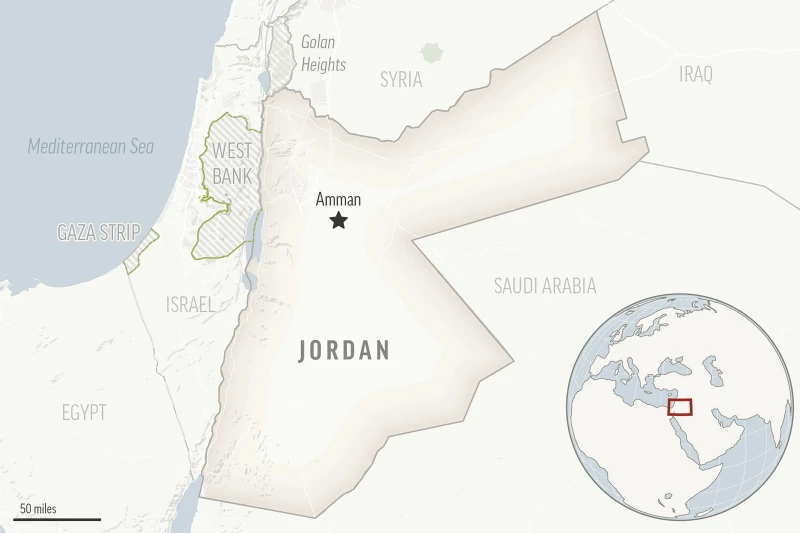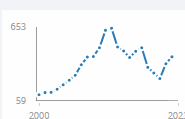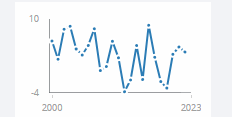Three US soldiers were killed and more than 30 injured, some critically, in a kamikaze drone attack last night on a small US post in northeast Jordan, according to news reports. Aside from a heart attack suffered by a contractor in a false alarm of an attack months ago, these were the first US military deaths in the area since the spate of more than 150 rocket assaults on US posts in Syria and Iraq began October 17. Probably they had been precipitated by false charges that the Israelis had bombed a hospital in Gaza City that day. The Islamic Resistance in Iraq, essentially a Web site for Iran-linked militias, took credit for the attack. But no militia would have dared a campaign on this scale without Tehran's approval. Tehran pays the militias' bills.
Tower 22 is about 13 miles from the al-Tanf garrison in southeast Syria near the highway between Baghdad and Damascus; see the map below. Iran and its militias use the highway to transport troops and supplies, especially to and from the Lebanon Hezbollah. Tower 22 is tiny, and one wonders if it even had an air defense system worthy of the name. That might account for the heavy casualties. The single drone hit near the barracks.
Tower 22 can supply al-Tanf and Jordanian sites but otherwise has no strategic importance that I know of. Al-Tanf does have strategic importance: It trains recruits in the Kurdish-led fight against the terrorist Islamic State in Iraq and The Levant. Had the Islamic Resistance had a tactical purpose in mind, it would have attacked al-Tanf. But this garrison is protected by US jet fighters. The most likely reason for sending a drone into Tower 22 instead would have been to kill US troops.
Probably Iran believes that Americans are too weak to respond to a deadly attack with one of their own.
Khamenei has often called Americans weak. "The main enemy of the Islamic Republic is arrogance which is manifested by the transgressing US regime....their people and their youth suffer from [an epidemic of] depression and suicide," he said in a 2019 speech .".....Politicians – or as you mentioned, first-rate imbeciles – become furious against the people of Iran and show this by abusing and insulting our people.
"All these are signs of the enemy’s weakness....When this Revolution was a weak sapling, all of them joined hands to uproot that weak sapling, but they failed. Today, that weak sapling has turned into this strong, pure and great tree and therefore, they will not be able to do a damn thing."
The well-publicized isolationist arguments of the Republicans, especially of former President Donald Trump, and the restrained responses of the US military Central Command to militia assaults so far, might have misled Iran's Supreme Leader, Ali Khamenei, into a miscalculation that the US would respond by withdrawing its 900 troops from Syria and perhaps even its 2500 troops in Iraq, which are there only at Baghdad's invitation. A US retreat would substantially extend the regional influence of Iran -- and of the other ally of the Syrian President and dictator, Bashar al-Asad, Russia.
If so, Khamenei erred. The US must retaliate in strength. Its honor in the Middle East is at stake. One possibility may be a Tomahawk attack on an Iranian military site like the centers of the Islamic Revolutionary Guards in Syria and Iran, perhaps launched from the USS Florida submarine in the region. Iran would find a Tomahawk ballistic missile hard to defend against: It flies below radar.
Khamenei's error, if that is what it was, could draw the US into a regional war. But it is even less likely that the Pentagon's policy of restraint will avoid war if it continues. US President Joe Biden says America will respond at a time and place of its choosing.
Reading between the lines, I suspect that Khamenei double-crossed Biden: That Biden offered restraint as long as Iran didn't kill American troops. Now that Iran has gone for the barracks, all bets are off.
The unwinnable war
Iran does not have an air force worthy of the name. It can't long fend off US air attacks. Can it afford to fight a war thar it can't win?
The answer isn't clear to me. On one hand, the unemployment rate has been rising in Iran for two years, to 11%; see the figure below. A war might take this excess labor off the restive streets. This could reduce public protrsts against Tehran'sOn the other hand, Iran is still a lower-middle class economy, with an average income below $4,700. Although gross domestic product, the value of domestic production, has risen for three years, much of this is due to inflation, now 43% per year; see the figure below. I doubt that the typical employed Iranian can afford an expensive war. The political benefits to Tehran of a war are likely to hold only in the short run. This is not to say that it might not try it, anyway. Jingoism distracts from a troubled economy.
Or Biden could toughen the sanctions on Iranian oil already on the books. This would hit the Iranians where it hurts. True, the absolute poverty rate in Iran is low -- less than 1% of the population lives on less than $2.15 per day, according to the World Bank (it says here). But the economy's growth rate fluctuates wildly, thanks largely to inflation; see the figure below. Cutting off oil exports would impoverish many Iranians. The central bank would undoubtedly respond by printing rials, maybe supplemented by a little foreign counterfeiting (it's happened before). Public protest could force Tehran to cave in without so much as a Tomahawk. In addition, sanctions avoid the deaths of the innocent that are unavoidable in any large air assault.
Sanctions have two problems relative to military attacks as a form of retaliation. First, they are unfair. They punish the typical Iranian, who had nothing to do with the Tower 22 assault. In contrast, a ballistic missile launched into a Revolutionary Guards center reaches the right folks. Second, sanctions are slow. The full reduction in output, and the full increase in inflation, may not appear for months or even years. Meanwhile, Tehran has no reason to lay off attacks on US posts. To the contrary: It may step them up, trying to blackmail the US into suspending the sanctions.
The main virtue of sanctions is that they are a long-run solution to a problem --Iran's mischief -- that the US finally recognizes as persistent. -- Leon Taylor, Baltimore tayloralmaty@gmail.com
Source: AP
GDP, current US dollars, 2000-2023. Source: World Bank
Annual real growth rates of GDP. Source: World Bank.
Notes
For useful comments, I thank, but do not implicate, Annabel Benson.
References
Khamei]ni, I. Why we believe the U.S. is weak - Khamenei.ir
Zeke Miller and Lolita C. Baldor. 3 U.S. troops killed in drone attack in Jordan by Iran-backed militia | AP News January 28, 2024
Phil Stewart, Steve Holland, and Idrees Ali. Three US troops killed, up to 34 injured in Jordan drone strike linked to Iran | Reuters January 28, 2024.





So Tower 22 and al-Tanf are both US bases? And Tower 22 is the one that the drone hit?
ReplyDeleteYes to both questions. Al-Tanf is a US garrison on the Syrian side of the border. It trains recruits for the fight against the Islamic State and, less officially, against Assad's dictatorship. Tower 22 is on the Jordanian side of the border and is essentially a warehouse of arms, although it also has air force personnel.
Delete